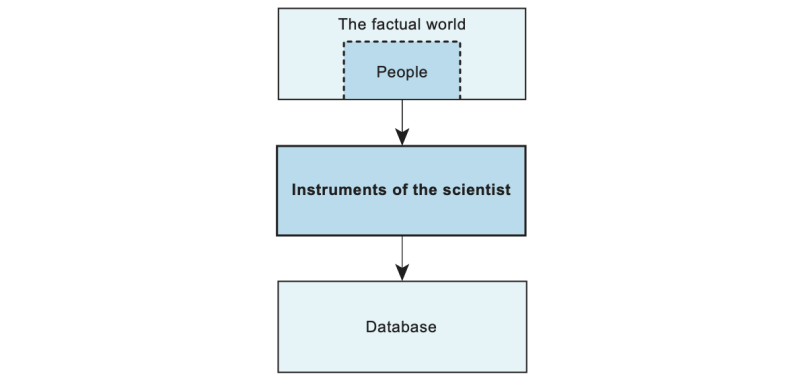
Measuring using instruments
Measuring with instruments is gathering data from the empery with instruments. In the past the scientists had to transfer the measured values to a database, but nowadays even this is done by a lot of the instruments themselves.
The basic idea of measuring is filling a database with information. Any database may do. It can be filled with texts, digits, but even objects or photos might be stored in a database. The two last ones are difficult to analyse, so most of the time the information consists of texts or digits. Databases with texts are usually analyzed with qualitative techniques and databases with digits are usually analyzed with statistics.
To collect the data, five ways can be distinguished. Observation is done with the senses of the scientist. Interviewing is making use of the senses of others. Measuring with instruments is the third one and the topic of this page. The other two are copy-paste from other databases and generating by machines as in simulation.
The information in the database should be valid and reliable. Senses aren’t really trustworthy. Dreaming, hallucinating, prejudice, wishful thinking, illusions and so on, influence the quality of the data. To prevent being misled, instruments are used. Instead of filling the database with information like ‘it looks pretty long’ the exact length in cm can be filled in.
A wide range of instruments can be distinguished, like instruments for measuring intelligence, blood pressure, knowledge, height, distance, air pressure, time and so on, and so on. All instruments measure different aspects of the empery (the real world) and some are objected to measure the same thing but in a different way. The way measuring takes place, is called operationalizing. The way measurements are operationalized, influences the type of variable you get for your data. Be aware of that.

The advantage of using instruments
Using an instrument has more advantages than the use of the senses:
- It is explicable how things are being measured
- Instruments can be tested on efficiency, reliability and validity
- The measuring can be repeated
- Norms about how to measure and norms about the outcome can be set
- Things that cannot be seen can be measured (for instance electricity or motivation)
- The values can immediately be added to the database
By taking out the activities of humans in the measuring process, the more objective the result of the measurement is. While observing bias can occur due to senses of the scientist. By interviewing bias occurs due to interpreting the answer of the respondent by the interviewer. In surveys bias might occur due to mistakes in copy pasting the answers of the respondents. In online enquiries all these kinds of bias cannot occur. This does not mean that the gathered information in the database perfectly represents the information in the empery. Bad questions and mistakes by the respondents are still a source of bias influencing the quality of the data.



